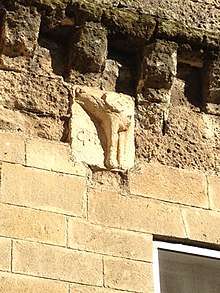Giovanni Pipino di Altamura
Giovanni Pipino di Altamura (Giovanni Pipino II or just Giovanni Pipino, Latin: Iohannes Pipinus) (death: Altamura, 1357) was an Italian nobleman and condottiero. He belonged to the Pipino noble family, which began with Giovanni Pipino da Barletta (death: Naples, 1316) and that, after just a few decades, declined.
Giovanni Pipino di Altamura | |
|---|---|
| Coat of arms |  |
| Died | 1357 Altamura, Kingdom of Naples |
| Noble family | Pipino family |
| Religion | Catholicism |
He was the count of Minervino Murge and Altamura, as well as the grandson of Giovanni Pipino da Barletta. Together with his brothers, he was well known for his violent character and arrogance towards the people he submitted. According to the sources, the brothers tried to subjugate many cities and territories of the Kingdom of Naples over the first half of the XIV century, taking advantage of the disorder and absence of power in the Kingdom of Naples which started right before the death of king Robert of Anjou. Giovanni Pipno di Altamura and his brothers didn't comply with the orders of the kingdom of Naples Robert of Anjou and, because of this and their arrogance, they were imprisoned. They managed to leave the prison only after the king's death. They often changed sides during their life: first, they fought for Andrew of Hungary, and then for Joanna I of Naples and his husband Louis, Prince of Taranto. Eventually, they backed Louis of Durazzo.[1][2]
Because of his character and of his disloyalty to the king, Giovanni Pipino di Altamura was captured in 1357 in Matera Castle and then he was brought to the nearby city of Altamura, where he was hanged to the battlements of Altamura Castle. According to what is written in the book Vita di Cola di Rienzo (written by an anonymous author), he had to wear a paper crown, because he called himself "king of Apulia".[3] His dead corpse was then dismembered in four parts by means of four horses, which were then displayed in some areas of the city of Altamura as a warning to the subjects. One of his legs was displayed on porta Matera, one of the main gates of the City Walls of Altamura. The leg was then replaced by a bas-relief depicting Pipino's coat of arms and his leg. The bas-relief was destroyed and rebuilt in 1648 because of the restoration of the city walls, and it's still visible on the right side of Altamura's gate porta Matera.[4][5]

Shortly thereafter, his brother Luigi Pipino was also captured and hanged on the battlements of the castle of Minervino Murge; while the last brother Pietro Pipino went into a self-imposed exile in Rome, losing all the property of his family and ending the Pipino dynasty.[6][7]
Coat of arms
The coat of arms of the Pipino family is shown in the tomb of Giovanni Pipino da Barletta (located in the church of San Pietro a Majella, Naples) and it's made of a gray background, and a light blue transverse band containing three golden shells.[8]
The coat of arms can also be seen inside the castle of Minervino Murge, but it's been partly damaged, presumably by his and his brothers' enemies.[9]
Family
- Nicola Pipino (great grandfather)
- Giovanni Pipino da Barletta (?-1316) (grandfather)
- Nicola Pipino (uncle)[10]
- Niccolò Pipino (father)
- Giovannella di Altamura (mother) - daughter of Giovanni di Sparano di Bari
- Angiola Pipino (aunt)
- Margherita Pipino (aunt)
- Maria Pipino (aunt)
- Pietro Pipino (brother)
- Luigi (o Ludovico) Pipino (brother)
- Matteo Pipino (brother)[11]
Sources
- Anonimo. Vita di Cola di Rienzo: tribuno del popolo romano. pp. 193–197.
- Domenico da Gravina (1349–1351). Chronicon de Rebus in Apulia Gestis.CS1 maint: date format (link)
- Giovanni Villani (1322–1348). Cronica (PDF).CS1 maint: date format (link) (In this book, Giovanni Pipino di Altamura is called "il Paladino", while his grandfather is called "Gianni Pipino")
- Matteo Villani (1562). Historia di Matteo Villani cittadino fiorentino il quale continua l'historie di Giouan Villani suo fratello, nella quale oltre a i quattro primi libri già stampati, sono aggiunti altri cinque nuouamente ritrouati, & hora mandati in luce. Et comincia dall'anno 1348. Con due copiose tauole, l'una de' capitoli, l'altra delle cose.
References
- pinto-2013
- https://condottieridiventura.it/giovanni-pipino-d-altamura/ Giovanni Pipino
- vita-cola, p. 196
- http://www.chieracostui.com/costui/docs/search/schedaoltre.asp?ID=17351
- http://murgiapride.com/2015/murgia-pride-app/it/Attrattive/La-Coscia-di-Pipino/
- http://www.treccani.it/enciclopedia/giovanni-pipino_%28Dizionario-Biografico%29/
- http://www.treccani.it/enciclopedia/pipino-conti-di-altamura_%28Enciclopedia-Italiana%29/
- pinto-2013, p. 98
- [[#pinto-2013|pinto-2013, pp. 37-38
- pinto-2013, pagg. 36
- http://www.treccani.it/enciclopedia/pipino-conti-di-altamura_%28Enciclopedia-Italiana%29/
Bibliography
- Francesco Pinto (2013). Giovanni Pipino - Un barlettano alla corte di tre re (PDF). Barletta.